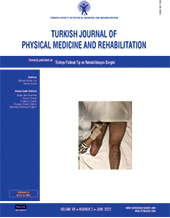Effects of splinting and three injection therapies (corticosteroid, autologous blood and prolotherapy) on pain, grip strength, and functionality in patients with lateral epicondylitis
2 Department of Physical Medicine and Rehabilitation, Gaziler Physical Therapy and Rehabilitation Training and Research Hospital, Ankara, Türkiye
3 Department of Physical Medicine and Rehabilitation, Ankara Training and Research Hospital, Ankara, Türkiye DOI : 10.5606/tftrd.2022.8007 Objectives: This study aims to compare the efficacy of the wrist splint and the injection of corticosteroid, autologous blood, and hypertonic dextrose in the treatment of lateral epicondylitis (LE).
Patients and methods: A total of 120 patients (43 males, 77 females; mean age: 45.7±7.7 years; range, 18 to 65 years) diagnosed with LE between December 2013 and June 2015 were included in the study and randomized into four groups. The first group was administered 20 mg methylprednisolone acetate + 2 mL 2% prilocaine, the second group 2 mL venous blood + 0.5 mL prilocaine, and the third group 2 mL 30% dextrose + 0.5 mL prilocaine injections. A second injection was administered to the third group one month later. The fourth group was recommended to use only a wrist splint. Pre-treatment and post-treatment evaluations of the patients were carried out at one and six months by the Visual Analog Scale (VAS) in terms of pain, by Patient-Rated Tennis Elbow Evaluation (PRTEE) questionnaire in terms of functional level, and by the Jamar dynamometer in terms of grip strength.
Results: In all groups, VAS values at one and six months after treatment were found to be lower in comparison to baseline. Except for the splint group, a significant improvement was observed in all three injection groups in terms of grip strength and PRTEE values at six months compared to the baseline values. In the comparison of the groups, no significant difference was observed in terms of improvement in VAS scores and grip strength. While corticosteroid injection was significantly effective in terms of PRTEE pain, function, and total scores only at one month, the autologous injection was effective in terms of PRTEE function and total scores at only six months after treatment. There were no significant differences for splint and prolotherapy groups in terms of PRTEE scores.
Conclusion: Corticosteroid injection, autologous blood injection, and prolotherapy are effective and safe long-term methods in LE treatment.
Keywords : Autologous blood injection, corticosteroid injection, lateral epicondylitis, prolotherapy

















